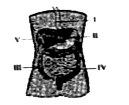Digestive system represents
a cell
a tissue
an organ
an organ system
Step-by-Step Text Solution:
1. Understanding the Digestive System: The digestive system is a complex network that is responsible for the process of digestion, which involves breaking down food into smaller components that the body can absorb and utilize.
2. Components of the Digestive System: The digestive system includes several key organs:
- Mouth: The entry point where food is ingested and begins to be broken down by chewing and saliva.
- Esophagus: Also known as the food pipe, it transports food from the mouth to the stomach.
- Stomach: A muscular organ where food is mixed with gastric juices for further digestion.
- Small Intestine: The primary site for nutrient absorption, where most digestion occurs.
- Large Intestine: Absorbs water and forms waste products for elimination.
- Anus: The exit point for waste material from the body.
3. Function of the Digestive System: The main function of the digestive system is to break down food, absorb nutrients, and eliminate waste. The stomach and small intestine are particularly important as they are where the majority of digestion and absorption take place.
4. Organ System Concept: The digestive system is not just a single organ but a system made up of multiple organs working together. This aligns with the biological hierarchy where:
- Cells form tissues,
- Tissues form organs,
- Organs form organ systems.
5. Conclusion: Therefore, the digestive system represents an organ system composed of various organs that work together to facilitate digestion and absorption of nutrients.
- Mouth: The entry point where food is ingested and begins to be broken down by chewing and saliva.
- Esophagus: Also known as the food pipe, it transports food from the mouth to the stomach.
- Stomach: A muscular organ where food is mixed with gastric juices for further digestion.
- Small Intestine: The primary site for nutrient absorption, where most digestion occurs.
- Large Intestine: Absorbs water and forms waste products for elimination.
- Anus: The exit point for waste material from the body.
- Cells form tissues,
- Tissues form organs,
- Organs form organ systems.
Topper's Solved these Questions
- ORGANISATION IN THE LIVING THINGSBOOK - BETOPPERSCHAPTER - ORGANISATION IN THE LIVING THINGSEXERCISE - Summative Worksheet (Multiple Choice Questions)
8 Videos
- ORGANISATION IN THE LIVING THINGSBOOK - BETOPPERSCHAPTER - ORGANISATION IN THE LIVING THINGSEXERCISE - Summative Worksheet (II. Fill in the blanks)
6 Videos
- ORGANISATION IN THE LIVING THINGSBOOK - BETOPPERSCHAPTER - ORGANISATION IN THE LIVING THINGSEXERCISE - Summative Worksheet (VIII. The organs of various systems are listed in the first column of the chart. Put a tick in any of the other columns if the organ belongs to any of the systems.)
1 Videos
- NUTRITION IN PLANTS AND ANIMALSBOOK - BETOPPERSCHAPTER - NUTRITION IN PLANTS AND ANIMALSEXERCISE - SUMMATIVE WORKSHEET (MATCH THE FOLLOWING)
3 Videos
- RESPIRATION AND EXCRETIONBOOK - BETOPPERSCHAPTER - RESPIRATION AND EXCRETIONEXERCISE - SUMMATIVE WORKSHEET ( ANSWER THE FOLLOWING QUESTIONS)
16 Videos
Similar Questions
Knowledge Check
The part of digestive system where no digestion occurs
AduodenumBoesophagusCstomachDmouthHuman digestive system does not hydrolyse
AstarchBcelluloseCglycogenDmaltoseTapeoworn has no digestive system because
AIt is parasiteBIt lives in intestineCIt does not need foodDIt absorbs its food from general body surface
Many secretory glands are present in the digestive glands. Thiese glands release digestive juices for the digestion of food. Which organ of the digestive system secretes bile?
View SolutionDigestive system begins with the
View SolutionFrog -Anatomy || Frog-Digestive system || Respiratory-system
View SolutionNutrional and Digestive System Disorders
View SolutionRepresent the digestive system by means of a labelled diagram.
View Solution

